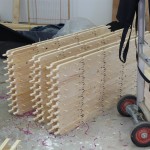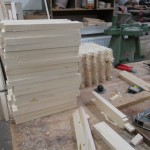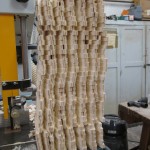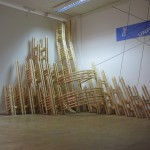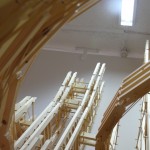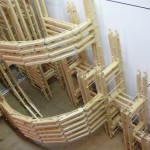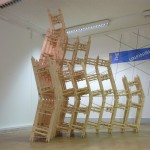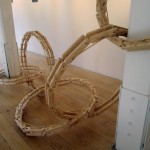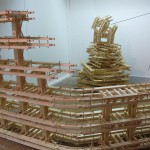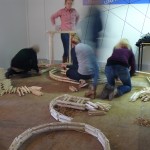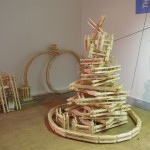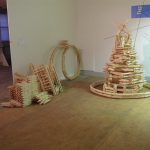The Unfinished Dome was the title of the final show for the Crawford School of Art & Design fine art masters program, 2013. Dimensions, Location Variable (DLV) was my piece in the exhibition. DLV is a modular, interactive, open-ended artwork, consisting of several hundred wooden components which can be assembled together in many different ways. It was designed over the course of several months, and each piece was individually cut with a band-saw and assembled by hand.
- Fabricating DLV
- Fabricating DLV
- Fabricating DLV
The idea of the piece was to challenge the static, finite status of most artworks, and to explore the nature of creative authorship and decision-making. Essentially, rather than make an individual artwork, I wanted to create a system for art creation, with a number of possibilities for construction, that I, or someone else could use to create their own artworks. During the exhibition, which ran over the course of two weeks, I changed the configuration of the work nightly.
- DLV - various iterations
- DLV - various iterations
- DLV - various iterations
- DLV - various iterations
- DLV - various iterations
- DLV - various iterations
As part of the exhibition, I invited a group of Interior Architecture students from St John’s Central College Cork to interact with the piece for one day, allowing them to create whatever they wanted out of the pieces, which would remain in place for the next day. They ended up making a Christmas tree (it was that time of year!) and a model of a penny-farthing bike. It was a fascinating exercise in which I got to see what other people, from a very specific background, would do collaboratively with the work.
- Interior Architecture Students
- Interior Architecture Students
- Interior Architecture Students
The piece reappeared in 2014 in the Cork Film Centre Gallery, Ballincollig, in the group show Indivisible, as a collaboration with Cork-based artist Cassandra Eustace. I made a dome-like structure from the components, and Cassandra projected a moving image piece onto and through the structure, and added additional reflective elements. In the fully light-proofed gallery this made for a very fluid and dynamic installation.
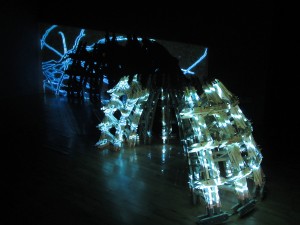
Dimensions, Location Variable artist’s statement:
The key concerns of my work in the final exhibition remain an exploration of decision-making and authorship in fine art practice, and an interrogation of the static nature of the three-dimensional works I had been making prior to beginning this course. To this end I have decided to use the two week run of the final show to produce and document the emergence of an interactive artwork, which I will partially or completely change every night while the show is closed to the public.
Materially, the work consists of a system of several hundred identical, wooden components which can be fitted together in a limited variety of ways. As I assemble the components each night, I am conscious of making decisions regarding the scale, shape and orientation of the emerging work. However, since the individual components themselves are designed to assemble and be articulated together in a finite number of ways, they themselves play a part in dictating the final outcome in any given iteration of the work. My principle interrogation is therefore one of locating the agency which actually produces the outcome, which appears to exist somewhere between my own decision-making process and the set of rules inherent within the components themselves, as well as the necessity of taking into account the effects of physics and gravity on the stability of larger structures.
The materials used are deliberately mundane and recognisable; planed timber, rubber bands and dowelling. The components emanate a handmade quality, with a familiar look, feel and smell, which might encourage the viewer to want to interact with them, perhaps causing a tension with the traditional gallery taboo on touching art. Also I feel there is an artistic value in the presence of the notion of repetitive, substantial labour inherent in the piece. This is present both in the lengthy process of the industrial fabrication of the components, and in the shift-work approach to modifying the piece every night.
Surrendering a portion of my authorship to a predetermined system is proving to be a fascinating prospect to me, the unpredictability of the outcomes have been capable of surprising me, and hopefully of providing a good range of interpretive possibilities. One viewer told me the particular iteration of the work she was considering made her think of both a shopping trolley and a cathedral. In some of the forms there is an allusion to architectural conventions, yet the constructions are too big to be architectural models, and too small and unstable to form any actual architectural function. I hope to explore the use of this system of art making further in future venues. I would be particularly interested in having it navigate gradually through a large environment and exploring the potential of documenting the outcome and using this documentation to feed into further artworks.

